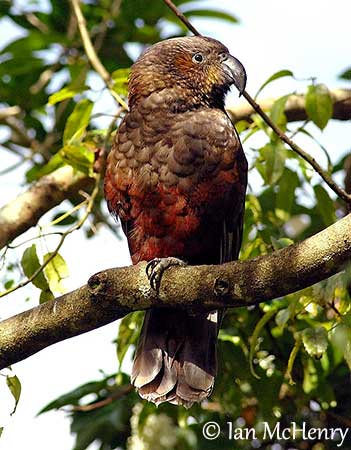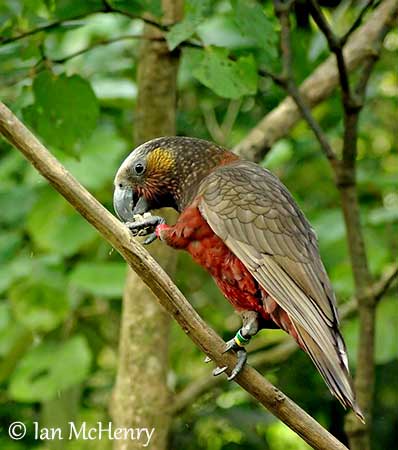
Fr: Nestor superbe
All : Kaka
Esp : Kaka
Ital : Kaka
Nd : Kaka
Russe : Кака
Photographer:
Ian McHenry
My New Zealand Birds
Text by Nicole Bouglouan
Sources:
HANDBOOK OF THE BIRDS OF THE WORLD vol 4 by Josep del Hoyo-Andrew Elliott-Jordi Sargatal - Lynx Edicions - ISBN: 8487334229
PARROTS OF THE WORLD – An Identification Guide – by Joseph M. Forshaw – Princeton University Press – ISBN 0691092516
KNOW YOUR NEW ZEALAND BIRDS by Lynnette Moon - New Holland Publishers – ISBN: 1869660897
BirdLife International (BirdLife International)
Wikipedia (Wikipedia, The Free Encyclopedia)
New Zealand bird status between 2008 and 2012
New Zealand birds and birding (Narena Olliver)
Te Ara – The Encyclopedia of New Zealand
New Zealand Kaka
Nestor meridionalis
Psittaciforme Order – Strigopidae Family
INTRODUCTION:
The New Zealand Kaka is a plump parrot, classified as vulnerable species, endemic to New Zealand. These birds are most abundant on predator-free offshore islands. On both North and South Islands, they have reduced range due to forest clearance and introduced mammal predators.
They frequent native forests, and are usually heard before to be seen.
DESCRIPTION OF THE BIRD:
Biometrics:
Length: 38-44 cm
Weight: 340-400 g
The Adult male of nominate race has brown and red plumage, becoming bronze according to the light.
The upperparts are mostly brown on back, wings and short tail. The upper back is rusty-red, as rump and upper tail coverts.
The underparts include brown throat and breast. Belly, vent and undertail-coverts are red-orange. The under tail feathers are brown, finely barred orange and with large brownish terminal band. The underwing is brown with mottled orange and whitish primary coverts, and brownish flight feathers.
The entire body presents scaled effect plumage, due to contrasting edges in feathers.

On the head, the New Zealand Kaka has whitish forehead, crown and nape, slightly edged buffy-brown. The face is brown, with pinkish and orange flecks, and there is an orange patch on the ear coverts. The chin is buffy-white with brownish edges, giving scaled effect too.
The strong, hooked bill is grey, with long upper mandible. The eyes are dark brown, with grey eye-ring. Legs and feet are grey.
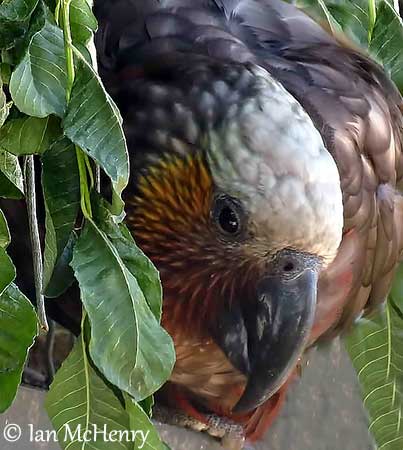
The female is similar to the male, with browner face and shorter, less curved bill.
The juvenile resembles adults and has paler eye-ring.
SUBSPECIES AND RANGE:
We can find two subspecies:
N.m. meridionalis (here described) occurs on South and Stewart Islands and larger offshore islands.
N.m. septentrionalis is found in North and offshore islands. This one is duller, darker and smaller than nominate.
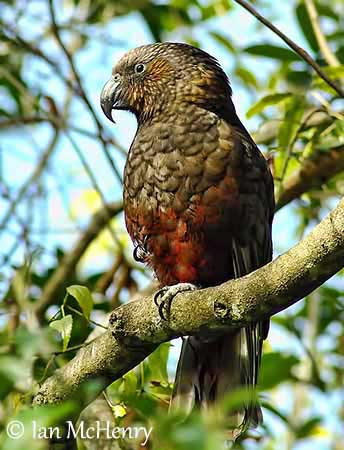
HABITAT:
The New Zealand Kaka frequents mainly the depths of forests with mature trees. It also can be found feeding in orchards and gardens. It can be seen from 450 to 1000 metres of elevation.
CALLS AND SONGS: SOUNDS BY XENO-CANTO
The New Zealand Kaka utters shrill, grating calls “ka-aa” in flight. But when jumping and tumbling through the branches and trees, it can utter melodious whistles and trills contrasting to the harsh cries given in flight. When disturbed, it gives a harsh “kraak”. A soft “tsee-tsee-tsee” call is uttered by the male during displays, prior to copulation.
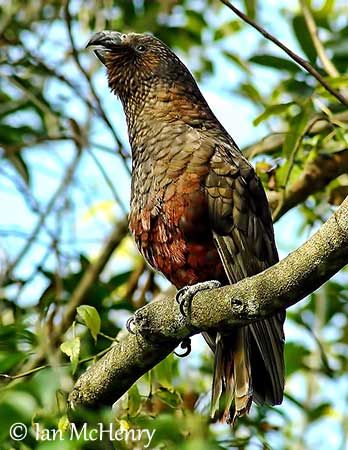
BEHAVIOUR IN THE WILD:
The New Zealand Kaka feeds on fruits, shoots and insects. It grips the fruit with its toes, and brings the food to its bill. In order to catch insects and larvae, it rips the bark with its strong bill for reaching hidden invertebrates and grubs in dead wood.
It has brush-tipped tongue, and it uses it for sipping some honey-dew from beech-trees. It also takes nectar from flowers, and sap from some trees. Seeds from Kauri’s cones are also eaten.
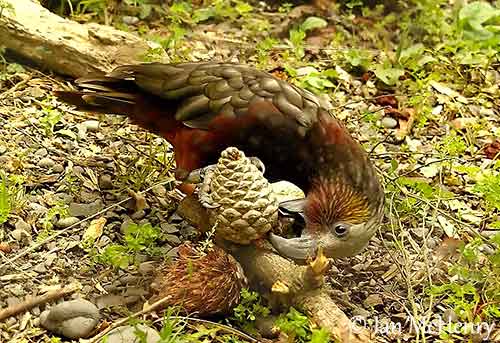
The New Zealand Kakas forage in pairs or in small groups, and are often seen in tree-tops or flying above the canopy. They feed in the morning and in late afternoon, and they rest in trees at midday.
Before to go to their roost, they perform noisy aerobatics, and can also call at night during the summer.
The New Zealand Kaka performs some displays during which it raises its wings, in order to expose its colourful under wings. This behaviour can be used as intimidation against rivals, or only to communicate between them within a group.
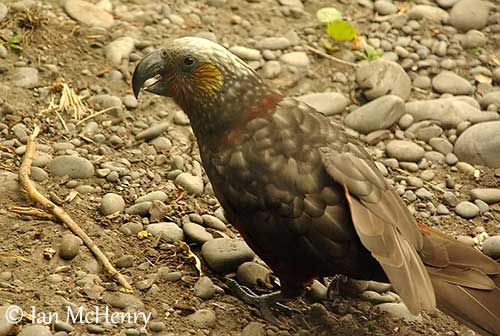
This species is nomadic, and move according to the food sources. It may perform altitudinal movements according to the season.
The New Zealand Kaka has strong flight, performed with flapping wing beats. It flies easily through trees and branches in forested areas. This bird is able to cross several kilometres from forested islands to the continent.
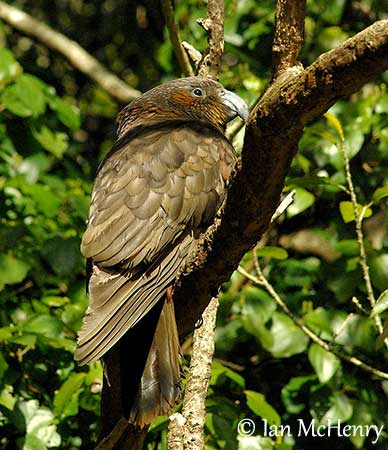
REPRODUCTION OF THIS SPECIES:
Breeding season occurs between September and March.
The New Zealand Kaka nests in deep cavities in large mature trees, at about three to six metres above the ground. The inner part is lined with soft wood dust.
The female lays 3 to 4 eggs on the dry lining. The incubation lasts about 24 days, mainly by female. The male collects food for her, calling softly for feeding her out of the nest by regurgitated plant matter. The female adopts the characteristic posture of “begging food” by crouching and quivering wings, and giving guttural, repeated calls “aa-aa”.
The chicks are fed by both parents but mainly by the male, and remain at nest for about 9 to 10 weeks. They depend on parents for food during 4 to 5 months.
This species has very low reproductive rate.
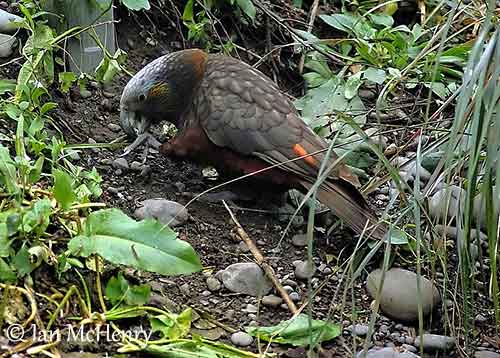
PROTECTION / THREATS / STATUS:
The New Zealand Kaka is threatened by habitat loss due to forest clearance for agriculture.
This species suffers heavy predation by introduced mustelids such as stoats, which enter nesting cavities, take the eggs and even kill the incubating female.
The species is currently classified as endangered species. The population is estimated at about 1,500/7,000 individuals.
